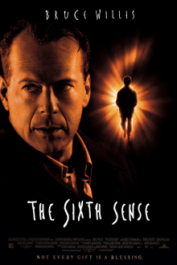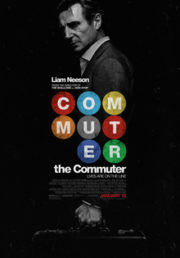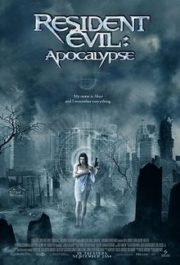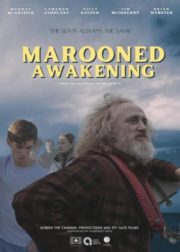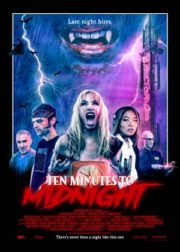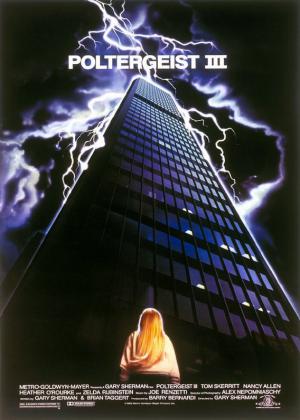
“Poltergeist III,” directed by Gary Sherman and released in 1988, is a chilling supernatural thriller and the final installment in the original “Poltergeist” trilogy. Set primarily in a high-rise Chicago apartment building, the film continues the terrifying story of the Freeling family as they face a malevolent force that seeks to possess their youngest daughter, Carol Anne. With its atmospheric setting, eerie visuals, and suspenseful sequences, “Poltergeist III” delivers a dose of supernatural horror that keeps viewers on the edge of their seats.
Plot Summary:
In “Poltergeist III,” Carol Anne Freeling (Heather O’Rourke) is sent to live with her aunt and uncle in a luxurious Chicago high-rise building known as The John Hancock Center. However, Carol Anne’s presence awakens the vengeful spirit of Reverend Henry Kane (Nathan Davis), who seeks to claim her soul. As Kane’s supernatural powers intensify, Carol Anne’s family and a parapsychologist, Dr. Seaton (Richard Fire), must race against time to save her from the clutches of the malevolent entity.
Eerie Atmosphere and Visuals:
The film successfully creates an eerie and foreboding atmosphere through its atmospheric setting in the high-rise building. The towering architecture and reflective surfaces add a sense of isolation and claustrophobia, enhancing the feeling of being trapped in a supernatural nightmare. The film’s visual effects, including mirror reflections and distorted realities, contribute to the unsettling ambiance and amplify the tension.
Supernatural Thrills and Suspense:
“Poltergeist III” delivers a series of suspenseful and supernatural moments that keep audiences engaged. From ghostly apparitions and eerie voices to terrifying encounters in the building’s mirrored hallways, the film builds suspense and delivers jump scares that heighten the sense of dread. The supernatural elements and the constant presence of danger create an ongoing feeling of unease throughout the narrative.
Character-driven Storytelling:
The film centers on Carol Anne Freeling and her struggle against the malevolent spirit. Heather O’Rourke delivers a convincing performance as the young girl plagued by supernatural forces. The audience becomes emotionally invested in her plight, as well as the determination of her family members to protect her. The film explores themes of family bonds, sacrifice, and the resilience of the human spirit in the face of overwhelming evil.
Expansion of the Poltergeist Universe:
“Poltergeist III” expands on the mythology established in the previous films, delving deeper into the origins and motivations of the supernatural entities. While it stands as a standalone story, the film also pays homage to its predecessors and provides closure to the Freeling family’s haunting saga.
Conclusion:
“Poltergeist III” is a haunting and suspenseful supernatural thriller that concludes the original “Poltergeist” trilogy. With its eerie atmosphere, visual effects, and chilling sequences, the film keeps viewers engaged as they witness the Freeling family’s battle against a malevolent force. While it may not reach the heights of the first installment, “Poltergeist III” offers a satisfying conclusion to the supernatural saga and delivers a thrilling and unsettling cinematic experience for fans of the horror genre.
Submit your review | |
"Poltergeist III," directed by Gary Sherman, serves as the third installment in the popular supernatural horror franchise. Unfortunately, this final chapter fails to recapture the thrills and chills of its predecessors, resulting in a lackluster and underwhelming experience.
The film takes place primarily in a high-rise apartment building in Chicago, where Carol Anne, played by Heather O'Rourke, is sent to live with her aunt and uncle in an attempt to protect her from the supernatural forces that have plagued her in the past. However, it doesn't take long for the malevolent spirits to find their way into the new setting, terrorizing Carol Anne and those around her.
One of the major shortcomings of "Poltergeist III" is its weak and convoluted storyline. The plot feels disjointed and struggles to maintain coherence, often relying on repetitive jump scares and predictable supernatural tropes. The film fails to introduce fresh ideas or expand upon the mythology established in the previous films, resulting in a lack of suspense and genuine scares.
Furthermore, the absence of key cast members from the previous films, most notably JoBeth Williams and Craig T. Nelson, is keenly felt. While Heather O'Rourke delivers a decent performance as Carol Anne, the rest of the cast fails to make a lasting impression, with shallow characterizations and lackluster dialogue. The absence of the strong familial dynamic that characterized the earlier films hampers the emotional investment in the story.
Visually, "Poltergeist III" offers some interesting moments with its atmospheric use of mirrors and reflections, creating a sense of distorted reality and unease. However, these moments are few and far between, and the overall cinematography lacks the creative and striking visuals that made the original "Poltergeist" a standout in the genre.
Additionally, the pacing of the film feels uneven, with slow and tedious stretches that hinder the overall momentum. The attempts at building suspense and tension often fall flat, leading to a lack of engagement with the unfolding events. The climax, while attempting to deliver a shocking twist, feels contrived and fails to leave a lasting impact.
In summary, "Poltergeist III" pales in comparison to its predecessors, lacking the depth and creativity that made the original film a classic. Its weak storyline, lackluster performances, and repetitive scares diminish its impact as a horror film. While it may still appeal to die-hard fans of the franchise or those seeking a nostalgic viewing experience, it falls short of delivering the scares and thrills expected from a supernatural horror film.








